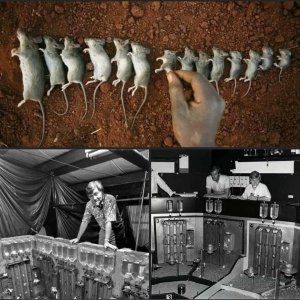- Feb 5, 2002
- 21,140
- 5,630
- 63
- Country
- United States
- Faith
- Catholic
- Marital Status
- Married
- Politics
- US-Others

The "Universe 25" experiment (sometimes referred to as the "Behavioral Sink" experiment) is one of the most terrifying experiments in the history of science, which, through the behavior of a colonies of rodents, is an attempt by scientists to explain human societies.
The idea of "Universe 25" Came from the American scientist John Calhoun, who began experimenting with Norway rats between 1958 and 1962. By 1968, he moved on to mice, and created an "ideal world" in which hundreds of mice would live and reproduce. More specifically, Calhoun built the so-called "Paradise of Mice", a specially designed space where rodents had an abundance of food and water, as well as a large living space. In the beginning, he placed four pairs of mice in the habitat, that in a short time began to reproduce, resulting in their population growing rapidly.
However, after 315 days, their reproduction began to decrease significantly. When the number of rodents reached 600, a hierarchy was formed between them and the so-called "wretches": the larger rodents began to attack the group, with the result that many males begin to "collapse" psychologically. As a result, the females in turn became aggressive towards their own young. As time went on, the females showed more and more aggressive behavior, isolation elements and lack of reproductive mood. There was a low birth rate and, at the same time, an increase in mortality in younger rodents.
Then, a new class of male rodents appeared, the so-called "beautiful mice". They refused to mate with the females or to "fight" for their space. All they cared about was food and sleep. At one point, "beautiful males" and "isolated females" made up the majority of the population.
According to Calhoun, the death phase consisted of two stages: the "first death" and "second death." The former was characterized by the loss of purpose in life beyond mere existence — no desire to mate, raise young, or establish a role within society. As time went on, juvenile mortality reached 100% and reproduction reached zero. Among the endangered mice, homosexuality was observed, and, at the same time, cannibalism increased, despite the fact that there was plenty of food.
Two years after the start of the experiment, the last baby of the colony was born. By 1973, the last mouse in Universe 25 had died. Calhoun repeated the same experiment 25 more times, and each time the result was the same. His work has been used as a model for interpreting social collapse, and his research serves as a focal point for the study of urban sociology.
We are currently witnessing direct parallels in today’s society: weak, feminized men with little to no skills and no protection instincts; overly agitated and aggressive females with no maternal instincts; and both of them offset with a preponderance of abnormal sexual trends that gravitate towards coitus as a means of pleasure or sport, rather than reproduction and nurturing.
Last edited:
